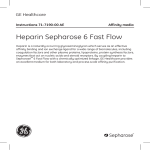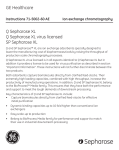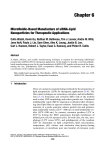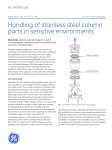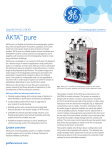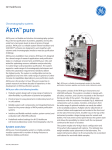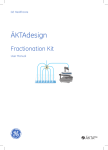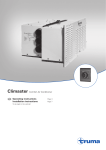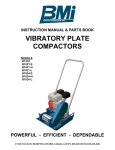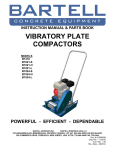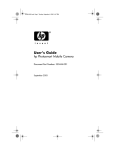Download Butyl SepharoseTM 4 Fast Flow Octyl Sepharose 4 Fast Flow
Transcript
GE Healthcare Instructions 71-5002-40 AD Hydrophobic interaction media TM Butyl Sepharose 4 Fast Flow Octyl Sepharose 4 Fast Flow Butyl Sepharose 4 Fast Flow and Octyl Sepharose 4 Fast Flow form part of the GE Healthcare media range for hydrophobic interaction chromatography (HIC). They TM also belongs to the BioProcess Media family. BioProcess Media are separation media developed, made and supported for industrial scale, especially the manufacture of health care products. With their high physical and chemical stability, very high batchto-batch reproducibility, and Regulatory Support File back-up. BioProcess Media are ideal for all stages of an operation – from process development through scale-up and into production. These instructions contain information about media characteristics, column packing, and maintenance. To ensure best performance and trouble-free operation, please read these instructions before using Butyl Sepharose 4 Fast Flow and Octyl Sepharose 4 Fast Flow. Contents 1. Characteristics 2. Column packing guidelines 3. Evaluation of column packing 3 6 15 4. Media and column maintenance 17 5. Further information 19 6. Ordering information 20 p. 2 1. Characteristics The base matrix, Sepharose 4 Fast Flow, is a highly cross-linked, 4% agarose derivative with excellent kinetics, making them ideal for process scale applications, particularly during initial capture and intermediate stages of a separation process when high flow rates are required. The high physical and chemical stabilities of the matrix prevent bed compression and formation of fines, and allow efficient maintenance procedures for increased media life time. A typical pressure flow rate curve is shown below for Butyl Sepharose 4 Fast Flow. Flow rate (cm/h) 500 400 300 200 0 0.2 0.4 0.6 0.8 1.0 1.2 Pressure (bar) Fig 1. Typical pressure/flow rate curves for Butyl Sepharose 4 Fast Flow in an XK 50/30 column, bed height 15 cm; mobile phase 0.1 M NaCl. p. 3 Table 1. Characteristics of Butyl Sepharose 4 Fast Flow. Matrix Type of ligand Bead form Mean particle size Particle size distribution Degree of substitution pH stability working range cleaning range Chemical stability Highly cross linked agarose 4% Butyl: R-O-CH2 -CH(OH)-CH2 -O-(CH2 ) 3 -CH3 Rigid, spherical, macro porous 90 μm diameter 45–165 μm approx. 40 μmol butyl/ml medium 3–13 2–14 Stable in commonly used aqueous buffers – 1 mM HCl, 1 M NaOH, (40 °C, 7 days), 30% isopropanol, 70% ethanol, 6 M guanidine-hydrochloride Autoclavable 20 min at 121 °C Linear flow rate at 25 °C ≥ 150 cm/h at 100 kPa (1 bar, 14.5 psi) XK 50/60, 25 cm bed height Operating temperature 4–40 °C Delivery conditions 20% ethanol *The actual loading capacity in a real working situation will depend on the nature and concentration of contaminants in the sample, and the degree of resolution required. p. 4 Table 2. Characteristics of Octyl Sepharose 4 Fast Flow. Matrix Type of ligand Bead form Mean particle size Particle size distribution Degree of substitution pH stability working range cleaning range Chemical stability Highly cross linked agarose 4% Octyl: R-O-CH2 -CH(OH)-CH2 -O-(CH2 ) 7 -CH3 Rigid, spherical, macro porous 90 μm diameter 45–165 μm approx. 5 μmol octyl/ml medium 3–13 2–14 Stable in commonly used aqueous buffers – 1 mM HCl, 1 M NaOH, (40 °C, 7 days) 30% isopropanol, 70% ethanol, 6 M guanidine-hydrochloride, 30% acetonitrile Autoclavable 20 min at 121 °C Linear flow rate at 25 °C ≥ 150 cm/h at 100 kPa (1 bar, 14.5 psi) XK 50/60, 25 cm bed height Operating temperature 4–40 °C Delivery conditions 20% ethanol *The actual loading capacity in a real working situation will depend on the nature and concentration of contaminants in the sample, and the degree of resolution required. p. 5 Method design and optimisation The main purpose of optimising a chromatographic step is to reach the predefined purity level with highest possible product recovery by choosing the most suitable combination of the critical chromatographic parameters. In process chromatography, in contrast to analytical or small scale preparative chromatography, this has to be accomplished as quickly and economically as possible, i.e. finding the conditions that give the highest possible productivity and process economy. Recommendations for optimising the critical operational parameters which affect the maximum utilisation of a HIC step can be found in our handbook: Hydrophobic Interaction Chromatography: Principles and Methods, Code number 18-1020-90, available from your local GE Healthcare office. Media screening To help with screening and selection of media, a HiTrap HIC Test Kit is available. It consists of 6×1 ml HiTrap columns packed with Phenyl Sepharose 6 Fast Flow (high sub), Phenyl Sepharose 6 Fast Flow (low sub), Phenyl Sepharose High Performance, Butyl Sepharose 4 Fast Flow, Butyl-S Sepharose 6 Fast Flow and Octyl Sepharose 4 Fast Flow, code number 11-0034-53. 2. Column packing guidelines General Purifying biological macromolecules by HIC is a typical high selectivity technique where the difference in retention for the molecules to be separated can be substantial at any specific ionic strength. Therefore, relatively short columns can be used if the selectivity of the adsorbent is exploited in an optimal way. Recommended bed heights range from 3 to 15 cm, which will minimise back pressure and allow high throughput. p. 6 Recommended columns Lab-scale columns TM • Tricorn 5/50 (5 mm i.d.) for bed volumes up to 1.1 ml at bed heights up to 5.8 cm. • Tricorn 5/100 (5 mm i.d.) for bed volumes up to 2.1 ml at bed heights up to 10.8 cm. • Tricorn 5/150 (5 mm i.d.) for bed volumes up to 3.1 ml at bed heights up to 15.8 cm. • Tricorn 10/50 (10 mm i.d.) for bed volumes up to 4.6 ml at bed heights up to 5.8 cm. • Tricorn 10/100 (10 mm i.d.) for bed volumes up to 8.5 ml at bed heights up to 10.8 cm. • Tricorn 10/150 (10 mm i.d.) for bed volumes up to 12.4 ml at bed heights up to 15.8 cm. • XK 16/20 (16 mm i.d.) for bed volumes up to 30 ml at bed heights up to 15 cm. • XK 26/20 (26 mm i.d.) for bed volumes up to 80 ml at bed heights up to 15 cm. • XK 50/20 (50 mm i.d.) for bed volumes up to 275 ml at bed heights up to 15 cm. Large scale columns TM • BPG , variable bed, glass columns: inner diameters from 100–450 mm, bed volumes up to 130 litres, bed heights max 58 cm. • INdEX variable bed columns: inner diameters from 70–200 mm; bed volumes up to 25 litres, bed heights max 61 cm. • CHROMAFLOW variable and fixed bed columns. Inner diameters from 280–2000 mm. TM TM p. 7 Packing process scale columns General packing procedures Columns can be packed in different ways depending on the type of column and equipment used. Always read and follow the relevant column instruction manual carefully. Sepharose 4 Fast Flow based media are easy to pack since their rigidity allows the use of high flow rates, see Fig 1. Three types of packing methods are described: • Pressure packing (for columns with adaptors) • Hydraulic pressure packing • CHROMAFLOW packing How well the column is packed will have a major effect on the result of the separation. It is therefore very important to pack and test the column according to the following recommendations. Begin the packing procedure by determining the optimal packing flow rate. Guidelines are given below for determining the optimal packing flow rates for columns with adaptors and fixed bed heights. Determining optimal packing flow rates The optimal packing flow rate is dependent on column size and type, medium volume, packing solution, and temperature. The optimal packing flow rate must therefore be determined empirically for each individual system. To determine the optimal packing flow rate, proceed as follows: 1. Calculate the amount of medium needed for the slurry (this is especially important for columns with fixed bed heights). The quantity of medium required per litre packed volume is approximately 1.15 litres sedimented medium. 2. Prepare the column exactly as for column packing. 3. Begin packing the medium at a low flow rate (30 cm/h). 4. Increase the pressure in increments and record the flow rate when the pressure has stabilised. Do not exceed the maximum pressure of the column, or the maximum flow rate for the medium. p. 8 5. The maximum flow rate is reached when the pressure/flow curve levels off or the maximum pressure of the column is reached. Stop the packing and do not exceed this flow rate. The optimal packing flow rate/pressure is 70–100% of the maximum flow rate/pressure. 6. Plot the pressure/flow rate curve as in Fig 1 and determine the optimal packing flow rate. The operational flow rate/pressure should be <70% of the packing flow rate/pressure. Note: For BPSS columns, first pack the column by suction packing at a low flow rate then determine the flow/pressure characteristics as above by pumping with downward flow through the column. Packing methods Pressure packing BPG columns BPG glass columns are supplied with a movable adaptor. They are packed by conventional pressure packing by pumping the packing solution through the chromatographic bed at a constant flow rate (or back pressure). 1. Pour some water (or packing solution) into the column. Make sure that there is no air trapped under the bottom net. Leave about 2 cm of liquid in the column. 2. Mix the packing buffer with the medium to form a 50–70% slurry. (Sedimented bed volume/slurry volume = 0.5–0.7). Pour the slurry into the column. Insert the adaptor and lower it to the surface of the slurry, making sure no air is trapped under the adaptor. Secure the adaptor in place. 3. Seal the adaptor O-ring and lower the adaptor a little further into the slurry to fill the adaptor inlet with packing solution. 4. Connect a pump and a pressure gauge, then start packing at the predetermined packing flow rate (or pressure). Keep the flow rate (or pressure) constant during packing and check the pressure at the column inlet. Never exceed the pressure limit for column or medium. p. 9 5. When the bed has stabilised, mark the bed height on the column tube, close the bottom valve and stop the pump. The bed starts rising in the column. Loosen the O-ring and lower the adaptor to 0.5–1 cm from the bed surface. 6. Seal the O-ring, start the pump and continue packing. Repeat steps 5 and 6 until there is a maximum of 1 cm between bed surface and adaptor when the bed has stabilised. 7. Close the bottom valve, stop the pump, disconnect the column inlet and push the adaptor down to approximately 3 mm below the mark on the column tube without loosening the adaptor O-ring. The packing solution will flush the adaptor inlet. Remove any trapped air by pumping liquid from the bottom (after the inlet tubing and the bottom valve have been properly filled). Hydraulic packing INdEX columns INdEX columns are supplied with a hydraulic function which allows an extremely simple, rapid and reproducible packing procedure to be used. The medium is packed at the same time as the adaptor is lowered into position at the correct pressure. The adaptor is pushed down by a constant hydraulic pressure, forcing water through the slurry and compressing it so that a packed bed is gradually built up. The hydraulic pressure can be generated using a pump and a pressure relief valve. 1. Pour some water (or packing solution) into the column. Make sure that there is no air trapped under the bottom net. Leave about 2 cm of liquid in the column. 2. Pour the slurry carefully into the column. Fill the column with buffer solution up to the edge of the glass tube. Mix the slurry and buffer solution. Allow the medium to settle to below the bevel (G) on the glass tube, see Fig 2. 3. Rest the adaptor against the bevel (G) on the glass tube. Tilt the lid slightly to avoid trapping air bubbles under the net when mounting it on the column. Lower and secure it in place. p. 10 4. Connect a pump to the inlet of the hydraulic chamber (A) in-line with a manometer and a pressure relief valve, between the pump and the hydraulic chamber. The manometer should be placed after the valve in the direction of the flow. 5. Open the hydraulic inlet (A) and the hydraulic outlet (C). Start the pump and flush the hydraulic chamber (E) free of air and any residual medium. 6. Close (C) and open the elution inlet/outlet (B) to expel trapped air in the adaptor net. 7. Close (B) and open the elution inlet/outlet (D) to start packing. Apply a pre-defined constant hydraulic packing pressure. 8. When the bed has finally settled (no flow at the column outlet), stop the packing procedure by closing (A) and (D). The adaptor stops moving when the hydraulic force, acting downwards is equal to the mechanical force of the bed, expressed upwards. 9. Run the column with upward flow for a few minutes to remove residual air trapped in the adaptor. The column is now ready for use. 10. To unpack the column, connect the outlet from the pump to (B) and open (C) while keeping (D) closed. This will cause the adaptor to rise from the bed surface. B C A G E A. B. C. D. E. F. G. Hydraulic inlet Elution inlet/outlet Hydraulic outlet Elution inlet/outlet Hydraulic chamber Slurry/Packed bed Bevel on glass tube F D Fig 2. Schematic representation of INdEX column with a 4-port (2-way) valve mounted at the bottom outlet. p. 11 Note: The hydraulic pressure used for packing is not comparable to the back-pressure generated when packing with a pump or pressure vessel. When using hydraulic pressure packing, the bed is mechanically compressed during the last part of the procedure. As a result, the flow properties of the packed bed will be limited by this mechanical compression. At any flow rate, the pressure drop over the bed under running conditions is higher than expected from the hydraulic pressure applied during packing. It is therefore important to carefully optimize the hydraulic packing pressure in order to achieve the same flow properties as for columns packed with conventional techniques using a pump. When packing Sepharose 4 Fast Flow media in INdEX columns to bed heights of 15 and 30 cm, the optimal hydraulic packing pressure is between 0.7 bar and 0.8 bar. The final mechanical compression at the end of the packing procedure should be about 5 mm. The degree of mechanical compression is critical for the flow properties of the packed bed. Packing CHROMAFLOW columns Procedure Prepare the column for packing as descriped in the User Manual. Packing from the top 1. Set the top nozzle to the pack position (mid-position). 2. Fully retract the bottom nozzle (run-position). 3. Ensure that the top mobile phase is closed. 4. Open the bottom mobile phase. 5. Open Inlet C and start the packing pump. Adjust the flow to achieve the required packing conditions for the selected medium. Monitor column pressure and the outlet flow rate in order to record column packing parameters. (Remember to stir the medium slurry during packing to prevent it from settling.) 6. Continue pumping until the column is fully packed and the pump stalls due to build-up of medium in its pipelines. Turn off the packing pump. p. 12 7. Fully retract the top nozzle to its run position. Close Outlet (C). Open Inlet (B) from the water/buffer tank and open Outlet (D). The pump should now be restarted to rinse the top slurry lines. (If the nozzle is full of liquid when in the packing position, make sure that the waste slurry outlet is open before retracting the nozzle.) 8. To clean-in-place, exchange the buffer tank for wash/buffer tank containing cleaning solution. Packing from below To pack from the bottom, carry out the same procedure for the connections and flow path via the bottom nozzle. The column is now ready to equilibrate and test. Note: It is also possible to use a slightly different packing method where the amount of medium is packed into the column causing compression of the bed. When all medium has entered the column the pump is stopped, the top nozzle is retracted, the bottom mobile phase valve closed and the medium is allowed to decompress within the column. p. 13 SLURRY INLET Packing position The top nozzle is extended part of the way (mid position) into the column. The bottom nozzle is fully retracted. Slurry enters the column via the top nozzle and excess liquid exits via the bottom mobile phase outlet. After packing, the slurry lines are isolated from the mobile phase and can be cleaned independently from the rest of the column. MOBILE PHASE MOBILE PHASE Running position The bottom and top nozzles are retracted. Mobile phase enters the column directly into an annulus, immediately behind the bed support. The annulus is cut through at an angle to ensure that linear flow rate is kept constant during distribution of the mobile phase across the bed. MOBILE PHASE BUFFER WASTE SLURRY WASTE SLURRY BUFFER Unpacking position In this position, both bottom and top nozzles are fully extended into the column, thereby exposing a third passage through which medium leaves the column. Cleaning solution can be pumped through the nozzles and sprayed into the column. In this way the column is easily and effectively cleaned without exposing the interior or the medium to the environment, or without dismantling the column. Fig 3. Princible of operation – CHROMAFLOW columns p. 14 3. Evaluation of column packing To check the quality of the packing and to monitor it during the working life of the column, column efficiency should be tested directly after packing, at regular intervals afterwards, and when separation performance is seen to deteriorate. The recommended method of expressing the efficiency of a packed column is in terms of the height equivalent to a theoretical plate, HETP, and the asymmetry factor, As. These values are easily determined by applying a sample such as 1% v/v acetone solution to the column. Sodium chloride can also be used as a test substance. Use a concentration of 2.0 M NaCl in water with 0.5 M NaCl in water as eluent. Sometimes a concentrated buffer solution, e.g. 10-fold is preferred. The calculated plate number will vary depending on the test conditions and it should therefore be used as a reference value only. It is also important that conditions and equipment are kept constant so that results are comparable. Changes in solute, solvent, eluent, sample volume, flow rate, liquid pathway, temperature, etc. will influence the results. For optimal results, the sample volume should be at maximum 2.5% of the column volume and the flow rate between 15 and 30 cm/h. If an acceptance limit is defined in relation to column performance, the column plate number can be used as part of the acceptance criteria for column use. Method for measuring HETP and A s To avoid dilution of the sample, apply it as close to the column inlet as possible. Conditions Sample volume: 1.0% of bed volume Sample conc: Eluent: Flow rate: Detection: Acetone: NaCl, buffer: 1.0% (v/v) acetone in water, 2.0 M NaCl or10× buffer 0.5 M NaCl in water, or dilute buffer 30 cm/h UV 280 nm; Conductivity p. 15 Calculate HETP and the number of theoretical plates as follows: HETP N L N Ve Wh where = L/N 2 = 5.54(Ve /Wh) = Bed height (cm) = number of theoretical plates = Peak elution distance = Peak width at half peak height Ve and Wh are in the same units. To facilitate comparison of column performance the concept of reduced plate height is often used. The reduced plate height is calculated as HETP/d where d is the mean diameter of the beads. As a guide, a value of <3 is normally acceptable. The peak should be symmetrical, and the asymmetry factor as close as possible to 1 (values between 0.8–1.5 are usally acceptable). A change in the shape of the peak is usually the first indication of bed deterioration due to use. Peak asymmetry factor calculation: A s = b/a where a = 1st half peak width at 10% of peak height b = 2nd half peak width at 10% of peak height As 0.8–1.8 (guide) Figure 4 shows a UV trace for acetone in a typical test chromatogram in which the HEPT and A s values are calculated. p. 16 UV absorption Column: BPG 300 Media: Sepharose 6 Fast Flow Bed height: 57.5 cm Bed volume: 40.6 litres Eluent: Distilled water Sample: 1.05 litres (1% acetone) Flow rate: 19 cm/h Ve = 18.7 Wh = 0.9 HETP = 0.024 cm a: 0.90 b: 0.85 As: 0.94 Wh a b Ve Volume Fig 4. UV trace for acetone in a typical test chromatogram showing the HETP and A s values are calculated. 4. Media and column maintenance Regeneration For best performance from the media, bound substances must be washed from the column after each chromatographic cycle. Wash with 2 bed volumes of water, followed by 2–3 bed volumes of starting buffer. To prevent a slow build up of contaminants on the column over time, more rigorous cleaning protocols may have to be applied on a regular basis. Cleaning-in-place (CIP) Cleaning-in-place (CIP) is the removal of very tightly bound, precipitated or denatured substances from the purification system generated in previous p. 17 purification cycles. If such contaminants accumulate on the column, they may affect the chromatographic properties of the column. If the fouling is severe, it may also block the column, increasing back-pressure and reducing flow rate. The following are suggested methods to remove strongly bound hydrophobic proteins, lipoproteins and lipids: • Wash the column with 4–10 bed volumes of up to 70% ethanol or 30% isopropanol followed by 3–4 bed volumes of water. Apply gradients to avoid air bubble formation when using high concentrations of organic solvents. • Alternatively, wash the column with 1–2 bed volumes of 0.5% non-ionic detergent (e.g. in 1 M acetic acid), followed by 5 bed volumes of 70% ethanol to remove the detergent, and 3–4 bed volumes of water. Caution: Specific regulations may apply when using 70% ethanol since it can require the use of explosion-proof areas and equipment. Consult your local safety regulations for more information. To remove other contaminants the following method is suggested: • Wash the column with 4 bed volumes of 0.5–1.0 M NaOH at 40 cm/h, followed by 2–3 bed volumes of water. The CIP protocols given above should be used as guidelines when formulating a cleaning protocol specific for the raw material used. The frequency of CIP will depend on the raw material applied to the column, but it is recommended to use a CIP procedure at least every 5 cycles during normal use. Depending on the nature of the contaminants, different protocols may have to be used in combination. If fouling is severe, the protocols may have to be further optimised. During CIP flow direction through the column should be reversed. Sanitisation Sanitisation is the reduction microbial contamination in the column and related equipment to an acceptable minimum. A specific sanitisation protocol should be designed for each process according to the type of contaminants present. The following is a recommended protocol. p. 18 Wash the column with 0.5–1.0 M NaOH at a flow rate of approximately 40 cm/h, contact time 30–60 minutes. Sterilisation To sterilise Butyl Sepharose 4 Fast Flow or Octyl Sepharose 4 Fast Flow, dismantle the column and autoclave the medium for 20 minutes at 120 °C. Storage Store Butyl Sepharose 4 Fast Flow and Octyl Sepharose 4 Fast Flow in 20% ethanol, at +4 to +30 °C, to avoid microbiological growth. 5. Further information Please read these instructions carefully before using Butyl Sepharose 4 Fast Flow or Octyl Sepharose 4 Fast Flow Medium. For further information visit www.amershambiosciences.com or contact your local GE Healthcare representive. p. 19 6. Ordering information Product Pack size Code No Butyl Sepharose 4 Fast Flow 25 ml 200 ml 500 ml 5 litres 17-0980-10 17-0980-01 17-0980-02 17-0980-04 Octyl Sepharose 4 Fast Flow 25 ml 200 ml 1 litre 5 litres 17-0946-10 17-0946-02 17-0946-03 17-0946-04 HiTrap HIC Test Kit HiTrap Butyl FF HiTrap Butyl FF HiTrap Octyl FF HiTrap Octyl FF HiPrep 16/10 Butyl FF HiPrep 16/10 Octyl FF Tricorn 5/50 Tricorn 5/100 Tricorn 5/150 Tricorn 10/50 Tricorn 10/100 Tricorn 10/150 XK 16/20 XK 26/20 6 × 1 ml 5 × 1 ml 5 × 5 ml 5 × 1 ml 5 × 5 ml 20 ml 20 ml 1 1 1 1 1 1 1 1 11-0034-53 17-1357-01 17-5197-01 17-1359-01 17-5196-01 17-5096-01 17-5097-01 18-1163-09 18-1163-10 18-1163-11 18-1163-14 18-1163-15 18-1163-16 18-8773-01 18-1000-72 Handbook Hydrophobic Interaction Chromatography and Reversed Phase Chromatography: Principles and Methods 11-0012-69 The complete range of Sepharose Fast Flow media includes other HIC media as well as media for ion exchange and affinity chromatography. Further information is available upon request. p. 20 Columns For information about process scale columns, please ask for the following Data Files. Data File Code No BPG 100, 140, 200, 300, 450 INdEX CHROMAFLOW 18-1115-23 18-1115-61 18-1138-92 p. 21 p. 22 p. 23 www.gehealthcare.com GE Healthcare Bio-Sciences AB Björkgatan 30 751 84 Uppsala Sweden GE Healthcare Europe GmbH Munzinger Strasse 5 D-79111 Freiburg Germany GE Healthcare UK Ltd Amersham Place Little Chalfont Buckinghamshire, HP7 9NA UK GE Healthcare Bio-Sciences Corp 800 Centennial Avenue P.O. Box 1327 Piscataway, NJ 08855-1327 USA GE Healthcare Bio-Sciences KK Sanken Bldg. 3-25-1, Hyakunincho Shinjuku-ku, Tokyo 169-0073 Japan All goods and services are sold subject to the terms and conditions of sale of the company within GE Healthcare which supplies them. GE Healthcare reserves the right, subject to any regulatory and contractual approval, if required, to make changes in specifications and features shown herein, or discontinue the product described at any time without notice or obligation. Contact your local GE Healthcare representative for the most current information. © 2006 General Electric Company – All rights reserved. GE Healthcare Bio-Sciences AB, a General Electric Company. 71-5002-40 AD 04/2006 Elanders Östervåla 2006 BioProcess, BPG, CHROMAFLOW, Drop Design, HiPrep, HiTrap, INdEX, Sepharose and Tricorn are trademarks of GE Healthcare companies. GE, imagination at work and GE monogram are trademarks of General Electric Company.
























